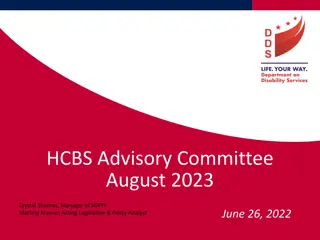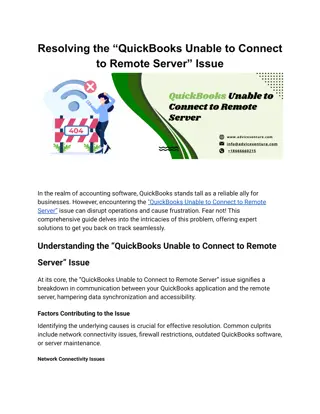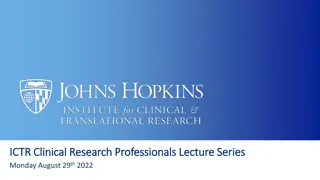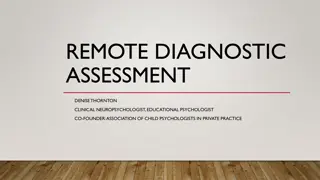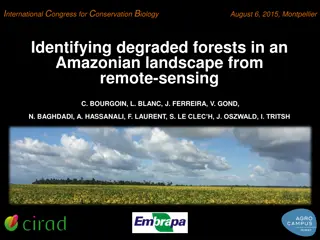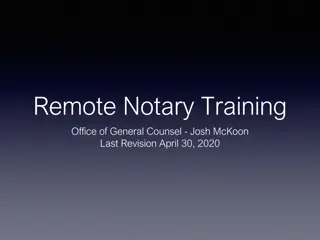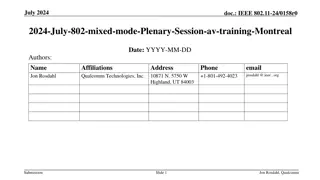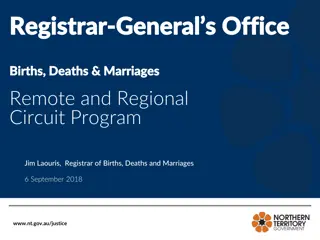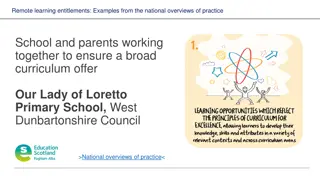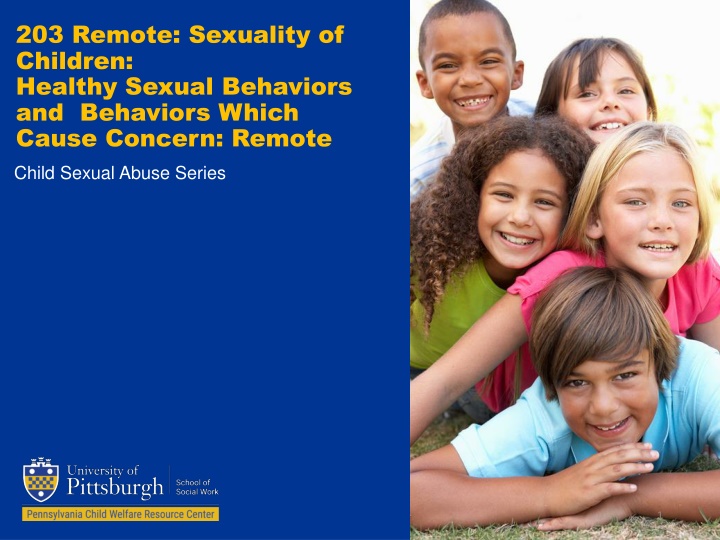
Healthy Sexual Behaviors in Children and Addressing Concerns
Explore the importance of recognizing healthy sexual behaviors in children, addressing concerns of child sexual abuse, and challenging common misconceptions. Learn about the need for comprehensive sexual education and supporting children's development in a positive manner.
Download Presentation

Please find below an Image/Link to download the presentation.
The content on the website is provided AS IS for your information and personal use only. It may not be sold, licensed, or shared on other websites without obtaining consent from the author. If you encounter any issues during the download, it is possible that the publisher has removed the file from their server.
You are allowed to download the files provided on this website for personal or commercial use, subject to the condition that they are used lawfully. All files are the property of their respective owners.
The content on the website is provided AS IS for your information and personal use only. It may not be sold, licensed, or shared on other websites without obtaining consent from the author.
E N D
Presentation Transcript
203 Remote: Sexuality of Children: Healthy Sexual Behaviors and Behaviors Which Cause Concern: Remote Child Sexual Abuse Series 1
Housekeeping 15 Min Rule Breaks & Lunch Zoom Rules Review Handouts Parking Lot Idea Catcher 2
Introductions Name Agency Length of Employment w/Agency Employment Duties WIIFCF 3
Training Agenda I. Welcome and Introductions II. Continuum of Sexual Behaviors III. Healthy Sexual Behaviors of Children IV. Sexually Reactive Children V. Application of Knowledge VI. Closing and Evaluation 4
Quote Sexuality is seldom treated as a strong or healthy force in the positive developments of a child s personality in the United States. We are not inclined to believe that our children are sexual or that they should be sexual in any of their behaviors. Although it is difficult to generalize in our pluralistic society, there is typically no permission for normal child sexual experiences. Children are not taught to understand their sexual experiences nor to anticipate sexual experiences as enjoyable. Rather they are taught to be wary of most sexual experiences, both interpersonally and instrapsychically. --Floyd M. Martinson. 5
Only 7% of American households believe that Sexual Education should NOT be taught in the schools. NPR (National Public Radio), the Kaiser Family Foundation, and Harvard's Kennedy School of Government. 6
Thought 1 Most adolescents engage in sexual relationships before 18. 7
Thought 2 Children who have been sexual abused are ruined by experiences. 8
Thought 3 All children are sexual beings. 9
Thought 4 Adults should not be naked in front of their children. 10
Thought 5 Children today know too much about sex. 11
Thought 6 Sexual identity is formed by age 5. 12
Thought 7 It is typical for children to touch other children. 13
Thought 8 Masturbation is morally wrong. 14
Thought 9 It is typical for children to insert objects in their private areas. 15
Johnsons Continuum Resource: Gil, E & Johnson, T. (1993) Sexualized Children & Treatment of Sexualized Children and Children who Molest. United States of America, Launch Press. 16
Normal Sexual Behavior Description: Child looks at and touches his/her own genitals; child exposes his /her genitals to other children. Distinguishing Characteristics: Mutual between children of same age and size; easily redirected. Purpose of the Behavior: To find out about same and opposite body parts 17
Sexually Reactive Description: Self-Stimulation; touching manipulations of genitalia, may engage other children in reenactments of sexual activity, insertion of fingers into genitalia, oral sex. Distinguishing Characteristics: Past sexual abuse or exposure to sexually stimulating experiences, child feels shame, guilt, and anxiety, not aggressive or demoralizing, no coercion or threatening behavior, occurs shortly after sexual abuse or sexually stimulating experiences, redirection possible. Purpose of the Behavior: To resolve confusion and anxiety regarding past experiences by re-enacting those experiences. 18
Extensive Mutual Sexual Behaviors Description: Adult sexual behaviors, thoughts and behaviors are pervaded with sexuality. Distinguishing Characteristics: Past sexual abuse, chaotic home life influences and persuades other children, engages in self-stimulation, cannot be redirected, intense treatment is needed, matter of fact attitude with other children regarding sexual behaviors. Purpose of the Behavior: To act out aggression that was done upon them, use power to control another, to gain or avoid emotional intimacy with others, uses sexual behaviors as a way of relating to peers. 19
Children Who Molest Description: Sexual behavior is impulsive, compulsive, and aggressive, behaviors consists of: rape, intercourse, anal penetration and forcible penetration of objects into genitalia. Distinguishing Characteristics: Meets needs at victim s own expense, forceful, looking for easy victims, age and size difference, behavior increases over time and becomes a pattern, lacks empathy & denies responsibility, history of sexual experiences, behavior problems in all settings, requires extensive specialized treatment. Purpose of the Behavior: Linked to feelings of anxiety, fear, confusion. 20
Activity 2 Identify a case from your own experience. Identify what category of Sexualized Behavior they would be classified as. Normal Sexual Behavior Sexual Reactive Extensive Mutual Sexual Behavior Children Who Molest Provide key information Present to class. 21
Group Activity List behaviors seen in the age group that reflect their sexual development. What are children this age thinking, doing, saying, that reflect their sexual development. Are there some Firsts that happen in this age group that impact sexual development. List some slang words you might hear from this group that describe sexual body parts. 22
Infants and Toddlers Normal Behavior Form attachments through physical touch Explore their own bodies Notice difference between boys and girls Establish gender awareness, identify, and roles Touch, grab, feel, and pull own body parts 23
Pre-School 3-5 year olds Normal Behavior Stronger sense of gender identity Increased self-stimulation Simple questions asked Curious about another s body Makes up names for specific body parts Plays games with other children regarding showing of body parts 24
Elementary School 6-10 year olds Normal Behavior Practice gender social roles Slang language usage Increased and more specific questions asked Talking about sex with peers of same gender 25
Pre-Adolescence 10-12 year olds Normal Behavior Puberty Boy/Girl relationships begin Sexual exploration with peers Interest in viewing other s bodies Compares body development to others Talking about body changes 26
Adolescence 13 years old and above Normal Behavior Dating begins Girls attracted to boys slightly older, and boys attracted to girls slightly younger Interest in viewing another s body May experiment with same-sex relationships Wide range of sexual activities Intercourse 27
Sexually Reactive Children Sexually Reactive Children can be defined as children whose repertoire of sexual behaviors exceed what is expected of their age. -Toni Cavanaugh, Ph.D. Sexually Reactive Children are pre-pubescent boys and girls who have been exposed to, or had contact with, inappropriate sexual activities. -Phil Rich, Ed.D., MSW, DCSW 28
Sexually Reactive Children Engage in behaviors beyond their age levels Engage in excessive play, inappropriate sexual comments & gestures Not easily redirected Past sexual abuse Over exposure to sexually explicit material Loose boundaries regarding sexual issues Excessive self-stimulation Experience shame, guilt, self-blame 29
Sexually Reactive Children Assessment What were the signs and symptoms the child displayed? What was the Behavioral Management Plan developed for the child? What were the recommendations given to the family involved regarding the child? 30
Interventions Explicit Communication Identifying and Offering Solutions Label/React Monitor Remove Sexual Stimuli Confront/Prohibit Refer 31
Masturbation When a child is older than 3, the child can do little else, (compulsive), the activity occurs in public places, the child avoids other childhood activities, the child insists upon inserting objects in the vagina or rectum, without regard to pain or self injury. Sgroi, S.M., Bunk, B.S., & Wabrek, C.J. (1988). Children s sexual behaviors and their relationship to sexual abuse. In S.M. Sgroi (Ed.), Vulnerable Populations: Evaluation and treatment of sexually abused children and adult survivors. Lexington, MA: Lexington. 32
Dynamics of Sexual Play vs. Problematic Sexual Behaviors Age Difference Size Difference Status Difference Types of Sexual Activity Other factors: How/Where It Takes Place How Persistent Is It How Does it Progress Distinguished Characteristics Behavioral Indicators Sexual Fantasy Secrecy Gil, E & Johnson, T. (1993). Sexualized Children, Assessment & Treatment of Sexualized Children and Children Who Molest. United States of America, Launch Press. 33
Case Scenario Assess two cases Identify healthy behaviors or problematic behavior and discuss reasons why 34



